By Dr. Gil Dekel
When Yehuda Halevi’s philosophical book ha-Kuzari was completed circa 1140, the moveable-type printing press was not invented as yet. And so, the book was copied by hand for over 350 years. Then, in the year 1506, the book was finally printed for the first time.
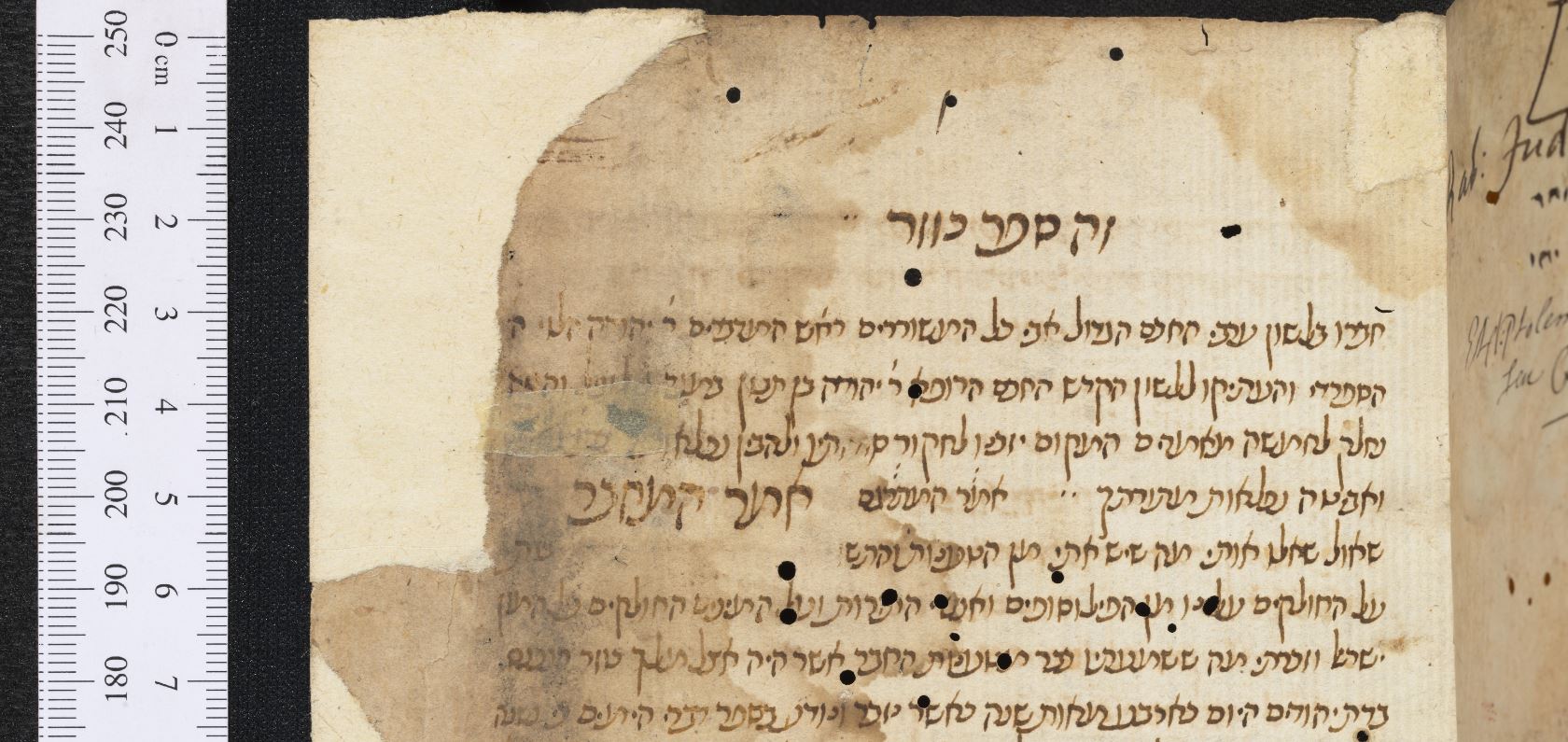
Detail from leaf 1r of ha-Kuzari, hand-copied edition. Date between 1401–1425. Photo © Bodleian Libraries, University of Oxford. Photo license: CC-BY-NC 4.0. [1]
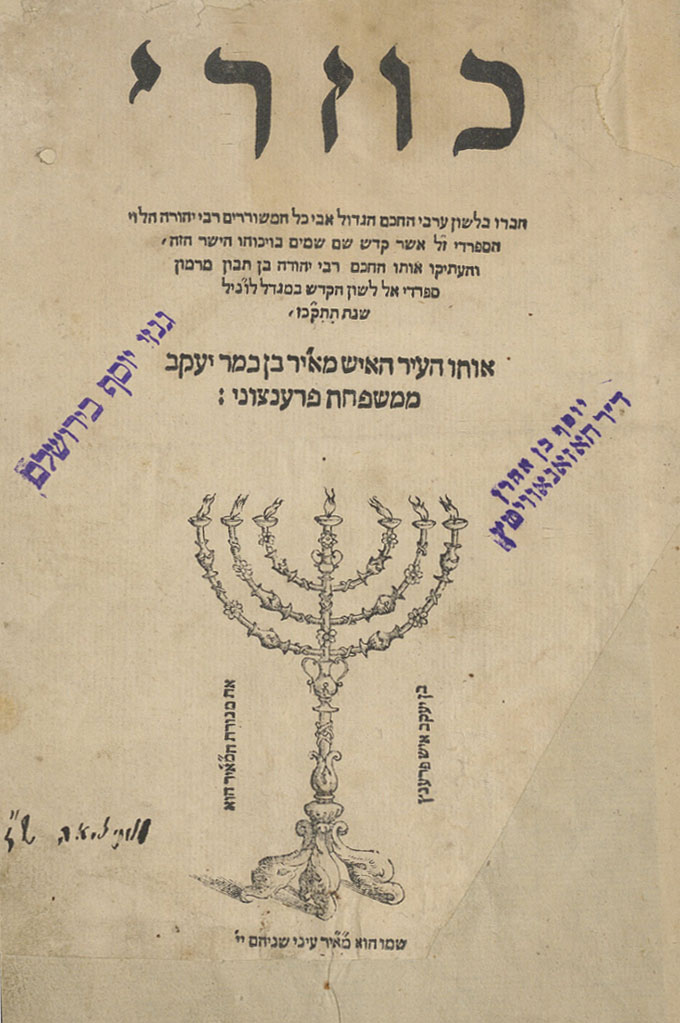
Kuzari, print edition from 1547, Venice. Collection of the Israeli National Library. Image in public domain. [4]
The 1506 print was commissioned by the Portuguese ibn Yahya family. They have also subsidized the book for dissemination in the Sephardic diaspora of the Ottoman Empire. [2] The benefactors ibn Yahya family consisted of three brothers: David, Shlomo, and Meir, the sons of Yosef ben David ibn Yahya, the Martyr. An introductory poem to the book was written (or commissioned) by Meir. [3]
I have located a copy of the book – not the 1506 edition – but an 1869 edition, published in Leipzig, Germany. This edition was brought to publication by Dr. David Cassel, who also wrote commentary and an introduction. In the introduction, on page 16, I have found a poem in Hebrew. Above the poem, in the German text, I could just about read the names: David, Shlomo, and Meir. Intrigued, I have commissioned a translation of the text.
Dr. Cassel describes his research and the history of the book. He states that the first (printed) edition of ha-Kuzari was commissioned by the sons – David, Meir and Shlomo – and published in Fano, Italy, at the print house of Gerschom Soncino (גרשום שונצינו) in 1506. “This very rare edition has on its title only the words [Sefer ha-Cuzar in Hebrew] ספר הכוזר, and on its back (in larger square lettering) the following poem:” [5]
The poem, as it was printed in Hebrew in the 1869 German edition:
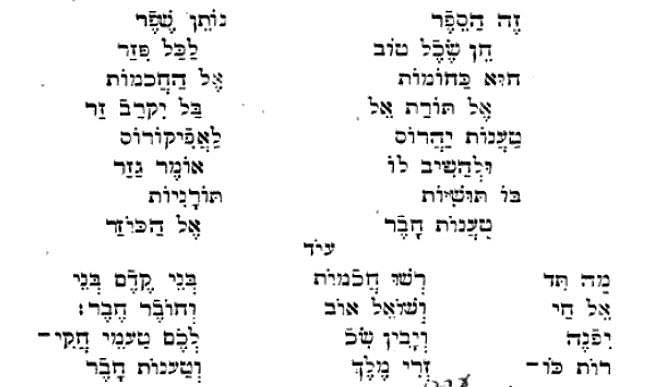
Dr. Cassel also mentions that the poem is acrostic (i.e. first letters in each line form a word). He suggests that the acrostic poem spells the full name of Meir in Hebrew: מאיר בן יוסף בן יחייא. Likewise, in 1932, A. M. Heberman argued that Meir “signed” his full name in the poem. [6]
I have so far managed to identify only the first name, Meir, מאיר, in the poem. I have marked it in red colour below:
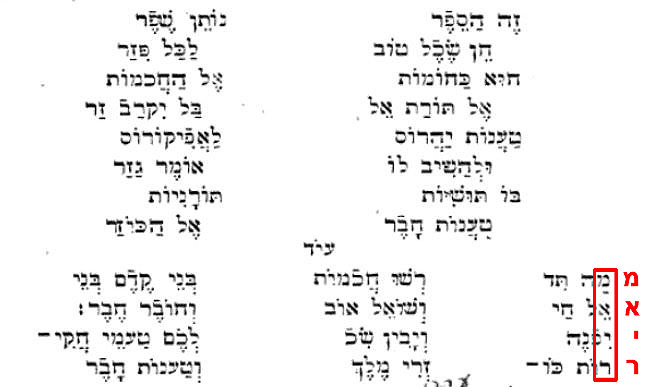
Dr. Cassel states that the following postscript was written, in Hebrew, after the poem:
ונחקק הספר הזה במאמר
אנשי המעלה והיחס והכבוד האחים יצו’ בני השוע הנעלה האשל האדיר השר דון יוסף [ב]ן יחייא איש לישבונא אשר במלכות פורטוגאל זל בן דון דוד [ב]ן יחייא בן דון שלמה [ב]ן יחייא בן הרב דון דוד [ב]ן יחייא אשר היה רב בממלכות קשתיליא בן דון גדליה [ב]ן יחייא בן [ד]ון שלמה [ב]ן יחייא בן דון יהודה [ב]ן יחייא הוא הראשון אשר בשם [ב]ן יחייא יכונה על שם אביו הנקרא דון יחייא [ב]ן יעיש זלהה והיתה השלמתו בשנה השלישית לפפא ייוליו השיני רום הודו שנת רסו לפק על ידי צעיר המחוקקים קטון התלמידים אשר מבני שונצ”ינו הוא ג”ר – שם בעיר פאנ”ו.
Yosef ben David ibn Yahya (the father of David, Shlomo, and Meir), was himself a patron of Hebrew manuscripts. One of his important commissions was a 1472 copy of Maimonides’ Mishneh Torah (Code of Law), embellished with impressive full-border illuminations. This manuscript survived, and can be viewed online. One leaf from the manuscript is shown below (more information in this link). [7]
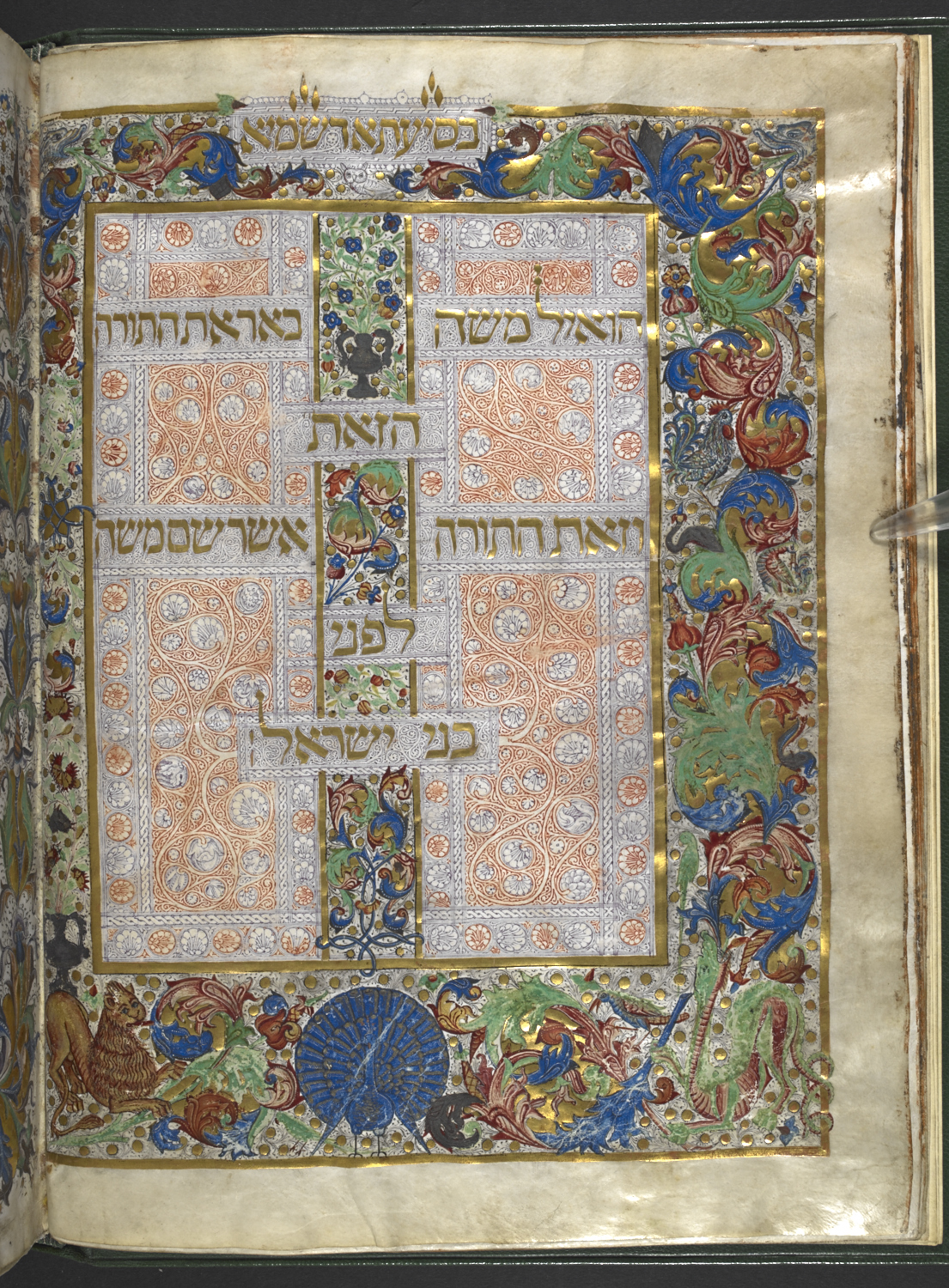
Excerpts from Maimonides’ Code of Law, embellished with sumptuous full-border illuminations. Mishneh Torah, Lisbon, 1472 CE (Harley MS 5698). Dimensions: 1105 × 1500. Location: British Library. Book commissioned by Yosef Ibn Yahya ben David. Artist: Solomon Ibn Alzuk. Image provided by the British Library, in a press releases kit, November, 2017. Image (c) British Library. Used here with permission.
The history of the publisher of the 1506 ha-Kuzari is also interesting. The publisher, Gerschom (also known as Hieronymus, Jeronimo, and Girolima), was the grandson of Israel Nathan, who established the family printing business around 1472, in Soncino, Italy. Israel set up a Hebrew printing-press, creating a Hebrew typeface. He printed the first complete Tanach תנ”ך (Hebrew bible) with vowels and accents in 1488. [8]
The publication of ha-Kuzari marks a shift in the way that the publisher Gerschom signed his name. Before ha-Kuzari, he would sign his name in the books that he published with “Gershom ben Moses of Soncino,” or “Gershom ben Moses the descendant of Israel of Soncino”. Later on, he called himself only “the least of the printers from the family of Soncino,” and in some prints he would not mention his name at all. It was in 1506, with the publication of ha-Kuzari, that he started to be playful with his name. He would split his name Gerschom to גר Ger and שם Shom – which is a play on words in Hebrew, meaning ‘He who lives there’. He would add the name of the city where his print house was based (he moved between a few cities), for example: גר שם בעיר פאנו – Ger Schom in the city of Fano. [9]
Another interesting figure relating to the book ha-Kuzari is its translator. The translator, Judah ben Saul ibn Tibbon יהודה אבן תיבון, translated the book from the Arabic text into Hebrew. Apart of his translation work, he was an avid book collector, known for having an extensive book library. He once said: “Let your bookshelves be your gardens.” [10] It could be said that the contributions of the ibn Yahya family to the printing of Hebrew books definitely helped generations of readers in developing their bookshelves ‘gardens’.
A short version of this article, in Hebrew:
ספר הכוזרי – נכתב על ידי יהודה הלוי, הושלם בערך שנת 1140. במשך דורות הועתק הספר בהעתקה ידנית, עד אשר הודפס לראשונה בשנת 1506. המממנים של ההדפסה הם שלושת האחים למשפחת איבן יחייא (בן חיים). הם גם סיבסדו את מחיר הספר. דוד, שלמה ומאיר, שלושת האחים, היו בניו של יוסף בן דוד בן חיים (איבן יחייא).
מאיר כתב, או מימן את הכתיבה של שיר המודפס בסוף הספר. השיר הוא אקרוסטי, כלומר אות ראשונה בכל שורה יוצרות מילה. זיהיתי את השם ‘מאיר’ בשיר – ראו תמונה פה למעלה. ייתכן שהשם המלא (כולל שם המשפחה) מופיע בשיר, אך לא הצלחתי לזהות זאת. מדפיס הספר היה בית הדפוס המפורסם, גרשום שונצינו. ההדפסה הראשונה היתה בעיר פאנו, איטליה.
גרשום היה חותם את שמו בספרים שפרסם. בהוצאת הספר הכוזרי הוא החל לחתום שמו כ:גר שם, ולאחריו הוסיף את שם העיר שבה התגורר באותה עת.
19 March 2021. Updated 1 Jan 2022. © Gil Dekel, PhD.
Images © as specified. Images of the poems in Hebrew are in public domain.
Note spellings variations:
Yehuda Halevi, Yehudah Haleṿi, Judah ha-Levi, רבי יהודה בן שמואל הלוי, ריה”ל
ibn Yahya, Chiya, Hiyya, Ben, Don Jachia בן חיים, איבן יחייא, חייא,
Footnotes:
- Judah, ha-Levi. The book ha-Kuzari in this edition appears in a collection of philosophical texts. (1401-1425). Place of Origin: [Provence?] At the Bodleian Libraries, University of Oxford. Shelfmark: MS. Bodley Or. 100. Catalogue Identifier: Neubauer 1230. Language: Hebrew. Accessed 10 March 2021, from: https://digital.bodleian.ox.ac.uk/objects/7e5c0cc9-3ef2-431a-9a36-a374c6d29607/ Terms of use: CC-BY-NC 4.0. Photo: © Bodleian Libraries, University of Oxford.
- Tirosh-Samuelson, Hava. (2009) “Adam Shear. The Kuzari and the Shaping of Jewish Identity, 1167–1900.” The American Historical Review, Vol. 114, Issue 3, June 2009, Pages 818–819.
- Menton, Arthur. (2021 [1996]) The Book of Destiny – Toledot Charlap – Chapter XXVI. Accessed 9 March 2021, from: https://www.poeticmind.co.uk/heritage/the-book-of-destiny-toledot-charlap-chapter-xxvi/
- Printed in Venice, Italy. 1547. Language: Hebrew.
מדפיס: פרענץ, מאיר בן יעקב, נפטר 1575 . וינייציא: דפוס מאיר בן יעקב ממשפחת פרענצוני. שנה ש”ז. הספר נסרק במסגרת פרויקט 450 שנה לספר העברי. מאוסף הספרייה הלאומית. - Judah, ha-Levi. (1869 [1140]) “Das” Buch Kusari. Translated [from Arabic to Hebrew] by Judah ben Saul ibn Tibbon. Leípzig. Publisher: F. Voigt. Edited with introduction by Dr. David Cassel. Language: German, with some sections in Hebrew, pp. 16-17. Pages 16-17 were translated from German into English for Dr. Gil Dekel in 2021.
- Heberman, A. M. (1932) The Printers of Concina Family. Their history and a list of Hebrew books they have printed. Vienna: David Frenkel Book Commerce House. Language: Hebrew. Page 49.
Translated from Hebrew by Dr. Gil Dekel, 2021. Heberman probably copied his information from another book: Manzoni, Giacomo. (1883-1886) Annali tipografici dei Soncino. I-III. Bologna. Language: Italian. - Dekel, Gil. (2021) Image added to the following article: article by Menton, Arthur. (2021 [1996]) The Book of Destiny – Toledot Charlap – Chapter XXVI. Accessed 17 March 2021, from: https://www.poeticmind.co.uk/heritage/the-book-of-destiny-toledot-charlap-chapter-xxvi/
- The Printing Museum. (n.d.) Brochure. Visit Soncino. Accessed 15 March, 2021, from: https://www.prolocosoncino.it/visit-soncino.php See also direct link to the brochure PDF: https://www.prolocosoncino.it/DoSITE.php?snd=file&act=download&mod=inglese&id=42
See also:
Heberman, A. M. (1932) The Printers of Concina Family. Their history and a list of Hebrew books they have printed. Vienna: David Frenkel Book Commerce House. Language: Hebrew. Pages 9-10. - Marx, Moses. (1936) “Gershom (Hieronymus) Soncino’s Wanderyears in Italy, 1498—1527 Exemplar Judaicae Vitae.” Hebrew Union College Annual, 11, 427-501. Accessed 16 March 2021, from: http://www.jstor.org/stable/23503142. Page 427, note 1.
- Quoted in Rothstein, Edward. (2009) “A Lifetime’s Collection of Texts in Hebrew, at Sotheby’s.” The New York Times, 11 February. Accessed 11 March 2021, from: https://www.nytimes.com/2009/02/12/books/12hebr.html?_r=1
